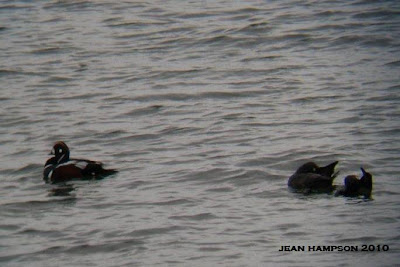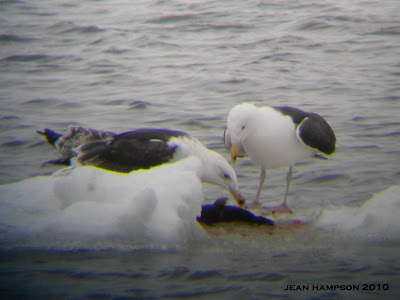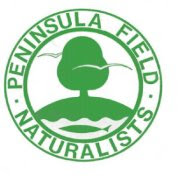
Sunday, April 25, 2010
Friday, April 23, 2010
Spring Count
Since 2008 Jean and I have assisted John Black with the local Christmas Bird Counts and MNR duck count. So when he called asking for our help with the Buffalo Ornithological Society (BOS) spring count we willingly accepted.
The BOS count (divided into sections) includes the Niagara Region in southern Ontario. As compiler of the section covering St. Catharines, Niagara-on-the-Lake (NOTL), Thorold and Niagara Falls, John assigned an area within the city of Niagara Falls to Jean and I. We covered the portion from Lyon's Creek Road/Main Street north to Steele Road/Portage Road and east of the Queen Elizabeth Way (a highway linking Toronto to Fort Erie, ON). Luckily the gulls at the Adam Beck Reservoir and along the Niagara River were counted by John and others. Hold that thought.
After looking over the maps and John's instructions, I thought it best we started along Lyon's Creek road south of the Welland River and work north towards the Niagara Escarpment. En route to Lyon's Creek Road we counted any birds spotted east of the QEW. Rural roads south of the Welland River were limited and did not take long to cover.
Starlings and American Robin were the majority in this area.
In Chippawa, we stopped at the boat ramp on the south side of the Welland River and at John's request, the bridge crossing the river and the feeders frequently visited by Niagara birders and members of the OFO on the Niagara River Gull Watch trip.

We walked under the bridge with hopes of ticking Barn Swallow. While under the west end of the bridge we observed nesting Rock Pigeon and mounds of their guano on the support beams. One Barn Swallow was spotted flying over the Welland River before it disappeared under the east side of the bridge.
The feeders were empty but still produced 15 species, including Yellow-bellied Sapsucker, Northern Flicker and White-breasted Nuthatch. Tufted Titmouse and Red-bellied Woodpecker usually found during our winter visits were not ticked this sunny spring day.
Heading along the Niagara Parkway, towards the Horseshoe Falls, we stopped at the Dufferin Islands Nature Area and walked along its trails before heading over to the engineerium to count the Black-crowned Night-Heron above the Falls. During the hour we surveyed the nature area, Jean and I observed a total of 25 species. Birds of interest included, Tree Swallow (4), Hermit Thrush (1) and Ruby-crowned Kinglet (1).



Our only concern above the Falls for the count was the Black-crowned Night-Heron roosting in the trees on the island behind the barge. Yes, a barge above Niagara Falls! Click on barge for the story on how it arrived to rest near the brink of the Horseshoe Falls.


I also noted, first of the year, black-headed Bonaparte's Gull for my provincial year list. We would see plenty more later in the evening.
We passed Table Rock and tourists at the Horseshoe Falls as we continued along the parkway, adding any birds spotted on the manicured lawns of Queen Victoria Park to the day's count. The only area we checked in the urban centre was a cemetery. More Robins and Starlings.
North of the city, we stopped at the Niagara Parks Botanical Gardens. Spring flowers and blossoms were blooming and we observed 16 species, adding a second Belted Kingfisher and Ruby-crowned Kinglet to our checklist.


After travelling along a few more roads, we stopped at Firemen's Park on the Niagara Escarpment for one last count on foot. No new species but a third Belted Kingfisher and 2 more Ruby-crowned Kinglets were added to our checklist.
The day's count appeared to be finished. The only raptor observed was Northern Harrier (1). Quite surprising we did not observe any Red-tailed Hawk along the highway corridor (the hawk's favoured hunting ground) or the farm-land south of the Falls. As we approached the northern boundary of our area on the QEW, what did we spot soaring above the highway? Two Red-tailed Hawks heading eastward and eventually falling within our area. The last addition for the afternoon.
In the early evening, Jean and I drove to NOTL to count Bonaparte's Gulls leaving the Niagara River. Upon arriving at Nelson Park near the NOTL marina, we found two floats of Bonaparte's sitting on the river. I started to count the gulls resting on the river and Jean counted the gulls flying by to spend the night on Lake Ontario.
1, 2, 3, 4, 5....

500, 501, 502, 503....

After counting the gulls on the water, I turned my attention to the Bonaparte's in flight while Jean scanned the flocks for Little Gull (gulls with black on the under-wing).
2500, 2501, 2502...That's a really cool sailboat! 2503, 2504, 2505....

For a little more than an hour we counted the Bonaparte's Gulls flying by our vantage point.
4250, 4251, 4252....

Will it ever end?

Though the larger, fast moving flocks proved difficult to count at times (especially as the sunlight faded). Jean and I counted a total of 7000 Bonaparte's Gulls. What about Little Gulls you ask? There were a total of 3 Little Gulls. No need to worry about finding one at the Whirlpool during the OFO trip at the end of November this year.
We observed a total of 42 species during 8 hours of birding. For the entire section, Jean and I were the only birders that found Ruby-crowned Kinglet, Hermit Thrush, Barn Swallow and Northern Harrier.
8 hours of birding! You think that would be enough and there are no more counts until the CBCs in December. Well, we'll be covering the same area once again for the second BOS count in mid-May. We should get some good birds on that count. At that time of year, migrating warblers will be at their peak. Oh, and the Bonaparte's. No endless flocks for the next count. They'll be on their breeding grounds by then. Here's hoping for a 50+ species day.
Friday, April 16, 2010
Paris to Ancaster
Here's some great footage from the 2009 Paris to Ancaster. St. Catharines' Jenny Brown can be seen riding through the creek bed while other riders make due on foot. I've never entered this race but I'm sure I would be one of the riders pushing or carrying their bike through that section. Other than a few spinning classes, I have to yet to sit myself down on a bike this year. I'll have to get out soon.
Birding on the other hand is going well. Last weekend, Jean and I assisted with the Buffalo Ornithological Society (BOS) spring count. Tale to be posted in the near future. This weekend is set aside for ticking Boreal species. Hopefully the Boreal tale will contain a lifer or two.
Sunday, April 11, 2010
Wednesday, April 7, 2010
A Love of Birds-Video
Those of you that subscribe to the Ontbirds report have most likely viewed the video below. The Ontbirds e-mail informed all that OFO member Doug Tozer successfully defended his Ph.D. at Trent University last week. He studied the Yellow-bellied Sapsucker in Algonquin Provincial Park.
For those birders outside of Ontario, the short video is about Doug and some of the birds you can find in Algonquin Provincial Park. Truly amazing footage of the park's birds.
Having viewed it myself, I find that I cannot wait for the upcoming trip Jean and I will be taking to the provincial park to observe some of the species found in the video. We're hoping for a lifer Evening Grosbeak.
Enjoy!
Tuesday, April 6, 2010
Two for the Price of One
The weekend arrived and unfortunately I had to work on the Saturday, leaving only one day to observe the grebe. On Sunday morning I checked the reports and the Western Grebe was observed at 8:00 AM. Perfect. Chances looked good for Jean and I to observe our second Western Grebe. Off we went to Saddington Park in Port Credit (Mississauga). Previous reports had the grebe moving between the west and east sides of the public park. When we arrived I could see two photographers and one birder with a scope at the west end of the park. They informed Jean and I that the bird was present and heading towards the barge and the Credit River at the east side of the park. We were also informed of another interesting species immediately west of the park.
The paved pathway provided easy access to the neighbouring cove and we had some great views of some waterfowl that are a very uncommon winter visitant (Bob Curry, Birds of Hamilton and Surrounding Areas). What duck could possibly have us momentarily setting a Western Grebe aside?

A Harlequin Duck (one male and two females)!





Sunday, April 4, 2010
Niagara Digiscoping
Our PC has decided it will no longer allow the transfer of images from Jean's camera to the computer. @%*&# PC! It is not the cable as an associate from the camera store suggested. Transfers work just fine on my mother-in-law's PC. It could be Norton causing the problem but for now posting birding tales with images will take longer than usual.
Thanks to Jean's mum, we finally have access to images that were taken over the last couple of months and some of them should have accompanied recent birding tales from the Niagara Region. What to do with the images now? Well, why not use them in a separate post? A post that will periodically appear between tales and since they are digiscoped images, mostly captured in the Niagara Region, call the post, "Niagara Digiscoping". Voila!
So without further ado, here is the first digiscoped image (of what I hope to be many) captured while birding in the Niagara Region.

This image was captured the long weekend in February while counting birds for the 2010 GBBC. Jean and I were birding along the Niagara River on February 14 when we came across two Great Black-backed Gulls sharing a romantic meal. Yes, on Valentine's Day! This would have been a great image to accompany the 2010 GBBC post. Unfortunately, technical difficulties prevailed.
I already have the next image planned. There may be some text accompanying it, then again, there may not. That's the beauty of Niagara Digiscoping. Oh, by the way. I hope to have the next tale, "Two for the Price of One", posted soon.






